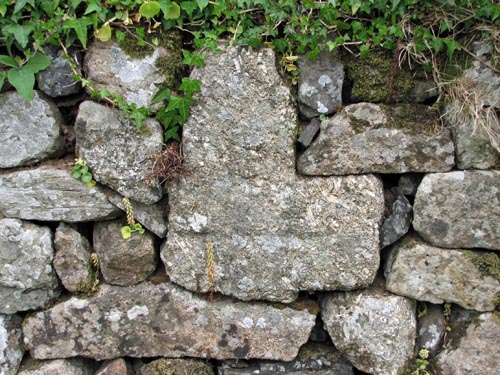 Location:
From South Brent, take the
road which runs north east towards Harbourneford. After about 2 kilometres,
take the first left at Harbourneford Cross and the lane leading to
Gisperdown Farm can be seen on your left after a further 1½ kilometres.
The cross is built into the wall to the right of the gateway and cattle
grid. Location:
From South Brent, take the
road which runs north east towards Harbourneford. After about 2 kilometres,
take the first left at Harbourneford Cross and the lane leading to
Gisperdown Farm can be seen on your left after a further 1½ kilometres.
The cross is built into the wall to the right of the gateway and cattle
grid.O/S Grid Ref: SX/70183/63037 Longitude/Latitude (Degrees+/-): -3.82998/50.45276 Map location: Click here to view map. Purpose: Not known Size: 1 foot 8 inches (0.51 metres) tall. 16½ inches (0.42 metres) across the shaft and the remaining piece of arm. The shaft is 9 inches (0.23 metres) wide below the arms, and the remaining arm is 8½ wide and protrudes from the shaft by 7 inches (0.18 metres). The arms of the incised cross measure 7½ inches (0.19 metres) from the centre. Information: This cross-head, which for years was lying on the ground inside the Gisperdown farmyard, has now been carefully built into the roadside wall at the entrance to the farm track. The history of this cross, prior to its removal from the farmyard, has been documented in Bill Harrison's book, 'Dartmoor Stone Crosses'. "The remains of a cross, comprising of a head with one arm missing, lie on the grass near the gate and within the farmyard. It has an incised cross on both faces.
The story of the relic now lying in the yard is interesting. About 1947 the farmworkers were preparing a wall bank and unearthed the cross-head in two pieces. Further delving failed to reveal the shaft. By the time Mr Codd had arrived on the scene the broken arm had been thrown back with the back-fill and the wall made good. The men had only considered the main part of the head as worthy of retention. Mr Codd had the wall dismantled again, but finding the missing arm proved to be a hopeless task and it is still in the bank at the south-east boundary wall of Dockwell Ridge (OS map ref. SX693637) to the east of ‘Willy Corner Gate’. Mr Codd has a conviction that this cross-head is the remains of one of the crosses marking the bounds of Brent Moor. The men at the tin workings at the other side of the River Avon, at ‘Wider Brook Clitter’, had used the shaft in the construction of the shelter. (I have used inverted commas for the place names, as my hearing was not quite sharp enough to pick up Mr Codd’s lovely dialect too well. Neither have I been able to obtain confirmation of the names). I wonder if Mr Codd’s native inborn hunch could be right? The inquisition of 1557 dealing with the bounds of Brent Moor named four crosses as boundary marks: Hobajon’s, Petre’s, Huntingdon and Buckland Ford. The first three still exist. Could the cross-head at Gisperdown be the missing Buckland Ford cross? The original width of the Gisperdown Cross across the arms must have been about 500mm so the cross would have been a reasonable size to be a boundary marker. Furthermore it is similar in size and rough Latin style to Huntingdon Cross, near neighbour to Buckland Ford. The tin workings to which Mr Codd referred are, I think, the ones between East and West White Barrows. It is unlikely that there is an unknown cross in this immediate area and it would have only involved a half-mile journey to transport the Buckland Ford cross to the workings. It is not easy to make a plausable cause for the discarded head except to say that at White Barrows it would have been nearer to Gisperdown than its original location of Buckland Ford. But all this is so much conjecture and, in the absence of hard facts, the verdict must be ‘history unknown’ like so many Dartmoor antiquities". |